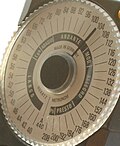Tempo

The first two measures of Mozart's Sonata XI, which indicates the tempo as "Andante grazioso" and a modern editor's metronome marking: "♪ = 120".
Tempo (Italian for 'time' from the Latin tempus[1]) is the speed of a song or piece of music. It is measured in beats per minute, or BPM. For example, if a song has 4 beats per bar at 100 BPM, there will be 25 bars per minute.
Basic tempo markings
From slowest to fastest:
- Larghissimo – extremely slow (24 BPM and under)
- Grave – slow and solem (25–41 BPM)
- Lento – very slow (38–57 BPM)
- Largo – slowly (47–60 BPM)
- Larghetto – quite broadly (52–64 BPM)
- Adagio – slow and stately (60–74 BPM)
- Adagietto – quite slow (60-68 BPM)
- Andante – at a walking pace (76–97 BPM)
- Moderato – moderately (98–112 BPM)
- Allegretto – by the mid-19th century, moderately fast (102–110 BPM)
- Allegro – fast, quickly and bright (115–143 BPM) (molto allegro is slightly faster than allegro, but always in its range; 124-146 BPM).
- Vivace – lively and fast (136–160 BPM)
- Presto – very quickly (162–200 BPM)
- Presto dur -- Very faster dur (172- 198 BPM)
- Prestissimo – extremely fast, even faster than presto (201 BPM and over)
Terms for tempo change:
- Ritardando – little by little slowing down
- Ritenuto - slow down suddenly
- Accelerando – gradually accelerating
- Rallentando - slowing down
Additional terms
- A piacere – literally "at pleasure"[2]
- A tempo – at the same speed from the beginning
- L'istesso tempo or Lo stesso tempo – at the same speed
- Tempo comodo – at a comfortable (normal) speed
- Tempo di... – the speed of a ... (such as Tempo di valse (speed of a waltz, ≈60 bpm), Tempo di marcia (speed of a march, ≈120 bpm))
- Tempo semplice – simple, regular speed, plainly
Common qualifiers
- alla – in the manner or style of, as in:
- alla breve – in short style,
- alla marcia – in the style of a march[3] (e.g., Beethoven, op. 101)
- all' ongarese – in Hungarian style
- alla (danza) tedesca – in the style of the Ländler (c. 1800), and similar dances in rather quick triple meter (see Beethoven, op. 79, op. 130)[4]
- alla turca – in the Turkish style, that is, in imitation of Turkish military music (Janizary music), which became popular in Europe in the late 18th century (e.g., Mozart, K. 331, K. 384)
- alla zingarese – in the style of Gypsy music
- assai – very much, as in allegro assai, quite fast[5]
- ben – well, as in ben marcato (well marked or accented)
- con – with,
- fugato – in fugal style,
- in modo – in the style of, in the style of: in modo napolitano (in Neapolitan style), in modo di marcia funebre (in the style of a funeral march)
- meno – less, as in meno mosso (less quickly)[8]
- appena – almost none,
- misterioso – mysterious
- molto – much, very, as in molto allegro (very quick) or molto adagio (very slow)[9]
- non troppo – not too much, e.g. allegro non troppo (or allegro ma non troppo) means "fast, but not too much"
- non tanto – not so much
- più – more, as in più allegro (more quickly);
- poco – little, as in Poco adagio
- poco a poco – little by little, bit by bit
- quasi – like a ... (Più allegro quasi presto, "faster, like presto")
- senza – without, as in senza interruzione (without pause), senza tempo
- sostenuto – sustained, prolonged
- subito – suddenly
Tempo Media
References
- ↑ Costa, Daniel (2024-07-25). "Tempo | Definition, Music, Description, & Notation | Britannica". www.britannica.com. Retrieved 2024-08-14.
- ↑ Apel (1969), p. 42; for the literal translation see the online Italian-English dictionary at WordReference.com.
- ↑ Apel (1969), p. 505.
- ↑ Apel (1969), p. 834.
- ↑ Apel (1969), p. 61.
- ↑ Online Italian-English dictionary at WordReference.com.
- ↑ Apel (1969), p. 112.
- ↑ Apel (1969), p. 520.
- ↑ Apel (1969), p. 537.
